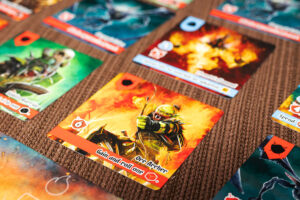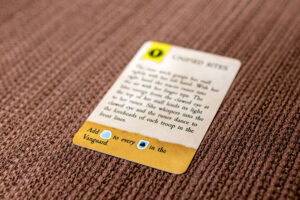 There a few themes in tabletop gaming that always pique my interest: theme parks, Lovecraftian, cyberpunk, and superheroes just to name a few. However, also among these favorites are siege games. I love how they pit an overwhelming force against a dug-in opposition. Recently, I reviewed Fire and Stone, a historical game about the Siege of Vienna in 1683. Today, we are going to take another siege game for a spin. But instead of embracing history, we are moving to the lands of fantasy, specifically Valeria, Daily Magic Game’s on created world. Get ready to take on the Seige of Valeria.
There a few themes in tabletop gaming that always pique my interest: theme parks, Lovecraftian, cyberpunk, and superheroes just to name a few. However, also among these favorites are siege games. I love how they pit an overwhelming force against a dug-in opposition. Recently, I reviewed Fire and Stone, a historical game about the Siege of Vienna in 1683. Today, we are going to take another siege game for a spin. But instead of embracing history, we are moving to the lands of fantasy, specifically Valeria, Daily Magic Game’s on created world. Get ready to take on the Seige of Valeria.
Gameplay Overview:
In this solo game, you have to try and defend your fortress against wave after wave of monstrous enemies. Your fortress has 5 columns of cards above it, each of which starts with 5 attacking cards. The last row of those columns will each have a siege engine. Taking out those is the goal of the game.

Each round has 7 phases, but the general direction of the gameplay will have you rolling all of your available dice, activating any siege engines in range, taking actions, advancing enemies remaining no the board, and then adding more waves of enemies.
Taking actions is where you’ll spend most of your time in the game. You’ll need to use your rolled dice to attack cards either at the front of each column, or any in-range siege engine. Every card has a number total that needs to be met to take out the card. Once a card is removed, you can then attack the card behind it.
In addition to removing an enemy from the battlefield, taking out a card also lets you add it to your hand to use its ability on a future attack. These give you power actions such as moving cards around the board, manipulating dice, or giving you bonuses to your attacks. However, once you are out of dice and actions for the round, any cards left in the vanguard (the first row of each column), will attack your fortress. Each of your five fortress sections can take 3 damage before it’s destroyed.

One other thing I should mention are the champion cards. Every time you destroy a siege engine, you get to add a champion to your fortress. These give you either one-time use powers, or repeatable actions to make an action stronger. However, they need to live in a fortress slot, and as those take damage, you’ll lose places to put your champion after a section takes its 3rd damage point.
There are 3 ways to lose Siege of Valeria: If a section of your fortress takes its fourth damage point, if a siege engine is in the vanguard at the end of the round, or if you run out troops in the enemy deck when you need to add to the battlefield. You win if you destroy all the siege engines in the game.

Game Experience:
I’ve been getting more into solo gaming these past few years, so I was keen on trying out Siege of Valeria. One thing I like is that it’s not a huge table hog. I was able to play on a coffee table while I watched some football on tv. Now mind you, it’s not exactly tiny either (like say Palm Island), having 25 square cards out on the table does take up some space, but I found it to be pretty manageable. FYI: you’ll be sliding cards around a lot, so having a playmat definitely helps.

For the gameplay itself, I found that it had a nice balance of dice rolling and card play. At the start of each round, you are rolling a satisfying pile of dice, however, those rolls can also make or break your turn. If you roll a ton of 1’s and 2’s, you’ll have a hard time taking out those 7-point troll brutes. Thankfully, that game gives you you a bit of dice manipulation in the form of the enemy cards (and to a lesser extent, the champion cards).
As I mentioned above, defeating an enemy will also give you a power to use. So that same troll brute? Once I take him out, I can spend his card to change any die to a 6. Other cards will let you double the value of a die, flip one to its opposite face, or even add a new die to your pool. There are also utility and defensive cards to help you mitigate damage or slide cards around the battlefield. You when you attack are a card, you’ll not only need to consider if it will damage you, but also how useful it’s ability will be once added to your hand.

One thing I didn’t talk about in the overview section were the event cards. The game suggests leaving these out for your first play to make things a bit easier, but these are cards that will randomly make enemies tougher (or sometimes give you a small boost). I left them out the first few times I played to wrap my head around the strategy of the game, and added them in once I had a feel for how to win. But it’s nice that they are optional for those that don’t like harder games.
Overall, I found the gameplay to be pretty tight, with most of my wins or losses coming right down to the wire. When I lose, it was usually by running out of troops vs taking too much damage. I think Siege of Valeria is a solid game, with my only concern being that it starts to feel a little samey after a while. While there is a decent variety in troop cards, for the most part you are doing the same thing from game to game.

However, one thing that could potentially help with that is the campaign expansion. This adds on some new content to the game by giving you boss cards, commanders, and elite troops to contend with (in addition to more of the cards for the core game). However, to help balance that out, you also now get duke cards and starter champions. Overall I liked the variety in this expansion and it definitely helped give the core game a bit more legs. My only knock is that the campaign itself is a tad weak. It’s basically just 3 games you play with a small penalty or bonus between each one. If you are looking for a fun campaign to play, this isn’t it. But if you just want more variety for Siege of Valeria, it’s a worthy add.
Final Thoughts:
For solo gamers looking for lots of dice rolling and thinky card play, Siege of Valeria is it. The game has a tight action economy where you’ll never feel like you have enough resources each turn. Yet it is definitely winnable (especially if you leave out the events). I’d also recommend the expansion for those that want more variety in the game.
Final Score: 3.5 stars – A solid solo game with lots of dice rolling and fun card play, made only better with the expansion.
 Hits:
Hits:
• Good amount of dice manipulation
• Tough decisions on who to attack and how to spend your dice
• Expansion adds in some nice variety
Misses:
• Feels a bit samey from game to game
• Campaign is kind of weak






















Funny: seeing your rating at google I expected a bad review for the game but your review is through out solid for the game. So it sounds more like a 4 Star review. Seeing the good looking artwork and how well balanced it is (mathemized – BGG, from the Dev.) I would even rate it a 4.5 for what it is. I am not sure what the game does wrong exept that you could say that you want to have some more cards -> AddOn.
A comment from a BGG user: surprisingly-solid and challenging solo game. It balances luck with good choices and feels pretty satisfying to play regardless of the results.
Interesting that you played it on the coffee table as this is the same way I want to play this little game too -> and this is a + too: quick to play, smaller play space size and the cards are good to read (no small fonts or icons).
So from me this game becomes a solid 4.5 🙂
One of the harder things to do is try and distill about 1000 words into a single number. So I always prefer people read the text over just the rating.